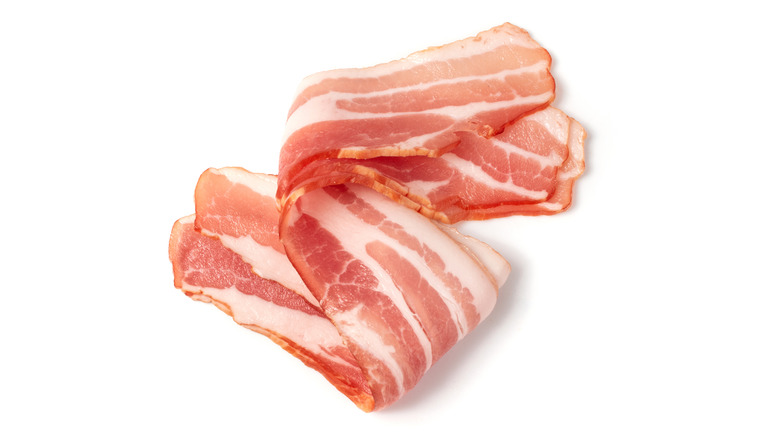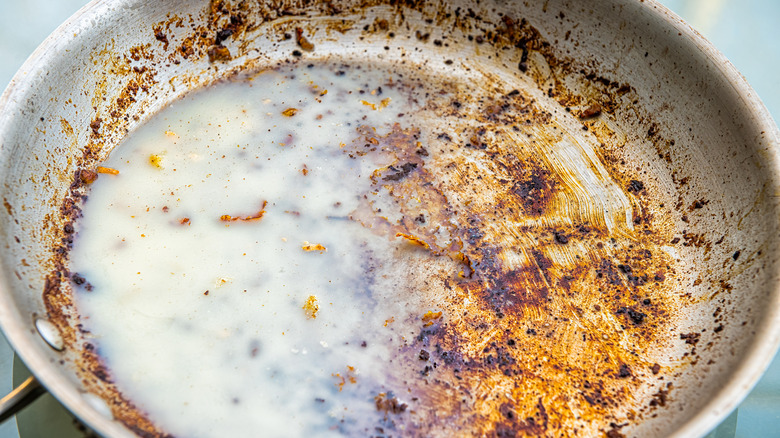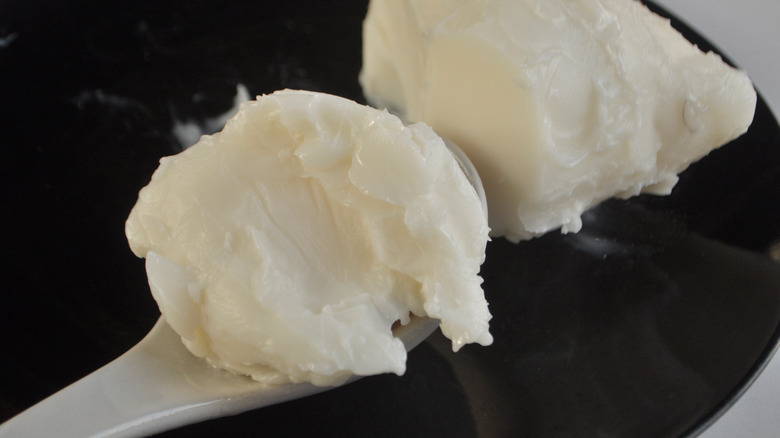How To Properly Discard Bacon Fat And Save Your Pipes
Bacon fat is the byproduct of one of the United States' most loved breakfast foods. FEE Stories estimate that, on average, Americans eat around 18 pounds of bacon each year. Multiplied by the size of your household, this can quickly add up to a massive volume of bacon fat that must be dealt with in one way or another. Animal fats can be detrimental to the plumbing in your kitchen and home, unlike vegetable or olive oils, which retain a liquid form. BBC's Science Focus reports that this difference lies at the molecular level of different fatty acids. Animal fats contain additional hydrogen atoms that can transform the chemical layout, allowing the resulting product to solidify, while plant-based oils that perform similar functions lack this feature.
A temperature of roughly 100 degrees Fahrenheit is required to melt solidified fats. This means that once the remnants of your bacon cooking cool down to room temperature, you can expect the fatty runoff to return to a solid state, whether it's sitting on the pan, in your pipes, or somewhere else. Bacon fat should always be discarded with care because the solidified mass can quickly gum your plumbing and may even require an expensive call out to a plumber to fix. Fortunately, it's a fairly simple task to properly take care of any leftover bacon fat.
Solid fat is easier to manipulate
Solid fat from cooked bacon or any other animal product is incredibly easy to manipulate. If you've cooked bacon in a pan, leaving the pan to rest until it returns to room temperature will give you the opportunity to simply scrape the solidified fat off of your cooking equipment. Using a rubber-coated spatula or other cooking utensils will protect the pan while giving you the necessary leverage to remove the fat from the surface.
The Spruce Eats also recommends pouring the liquid fat into a container of some kind. An old milk carton, sauce jar, shaped aluminum foil, or any other container that won't warp with the heat should do the job. After waiting for the fat to harden with its return to room temperature, you can simply throw away the container and solidified fat. In addition, promptly cleaning your cookware each time you cook fatty meats like bacon is the best way to ensure a long and useful life for your equipment. However, not everyone is entirely diligent when it comes to cleaning. Epicurious reports that using steel wool to carefully scrape away crusted and burnt-on fat residue can return a pan to its former glory. Just be sure to clean the pan thoroughly with dish soap and water after scrubbing it.
Store excess fat as an alternative to cooking oil
One thing that many people fail to realize, is that bacon fat (and every other animal fat that is given off during the cooking process) can become a secret weapon in the kitchen. When cooking any type of meal, one of the first things you'll do is add some form of grease to the cooking surface: Your fat of choice may be olive oil, vegetable oil, or butter; some steak lovers even use mayo to form a crispy sear, notes Anova.
Instead of reaching for an expensive bottle of oil, saving your bacon fat can give you a totally new flavor and approach to meal preparation. Transfer the hot fat to a container, the same way you would if you wanted to throw it away, but instead store it in the fridge for later use. This will give you a significant amount of bacon-flavored cooking fat that's perfect for roasted vegetables, baked goods, and even as a spread for making grilled cheese sandwiches or other similar concoctions, via The Pioneer Woman. It's easy to overlook the value of bacon fat, but understanding the immense flavor that it can provide, while cutting down your dependence on more expensive oil products, may just change the way you look at food forever.


